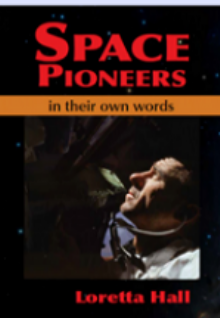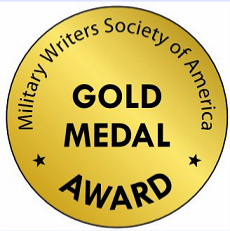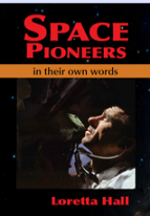Introduction
A cube of bronze glass supported at two corners by massive stone pillars, the New Mexico Museum of Space History sits on a ledge part way up a mountain, overlooking Alamogordo. Several steps downhill and across the access roadway sits the museum's Hubbard Space Science Research Building. The simple appearance of the small building belies the treasure trove it contains. While the impressive museum building houses artifacts that visually portray mankind's history of space exploration, the Hubble building protects written documents, photographs, and audio and video recordings of activities that made space travel possible.An important component of that collection is the oral history program, which is funded by the International Space Hall of Fame Foundation. Its value is explained by museum staff in this statement:
While the official governmental and private industry reports reflect the results of [space development] activities, such reports are "cut and dried" and reflect the technical aspects of the various programs. The human element is missing from such reports. The New Mexico Museum of Space History Oral History Program is attempting to recapture the history of "the old days" and in particular, the activities of the various individuals involved in these momentous events. No activity is considered too small to be recorded and preserved for posterity.
A visit to the museum in southern New Mexico is a rich experience because of the many outdoor and indoor exhibits that depict space research from 1930 to the present day. The documents stored in the Hubble building, however, are available only by arrangement to "legitimate researchers." The museum staff have provided access to the oral history transcripts for the purpose of writing this book, making substantial portions of those valuable recollections fully available to the general public for the first time. They present vivid accounts of daily life as well as the research activities that have taken place during the past seventy years in various phases of the US space program.
Since the New Mexico Museum of Space History Oral History Program began in 1986, 140 people have been interviewed. Ninety of them are represented in this book, their stories spanning the time period from the end of World War II through the space shuttle era. As of this writing, nineteen of the space pioneers quoted in this book have been inducted into the International Space Hall of Fame. Many will never be chosen for that distinction, as they were smaller cogs in the gears that propelled space research. Whether individuals became famous or contributed in a nearly anonymous way, their thoughts and experiences offer unique glimpses into the activities that shaped various aspects of America's space programs. As the United States moves into the future of space exploration along with international partners, it is important to look back at the way individuals worked together to produce incredible technological advances over a relatively short time span. Their stories provide insight into the past and inspiration for the future.
These oral history recordings and transcripts, along with other documents and photographs, are valuable assets for this country. They exist because of the vision and dedication of the staff of the museum in Alamogordo, so it is fitting to begin this journey through space history by understanding how the museum came into being.
On July 24, 1973, Dwight Ohlinger told several friends he thought a space hall of fame should be established, and that Alamogordo would be the right place to build it. Ohlinger had moved to that southern New Mexico city in 1950 and served as its mayor in the mid-1960s. His suggestion drew enthusiastic support from the group, and a few days later, New Mexico Governor Bruce King issued a proclamation naming Alamogordo as the site for the International Space Hall of Fame. An outpouring of support arose among the state's cities, counties, legislature, and US Congressional delegation. The New Mexico American Revolution Bicentennial Commission proposed that the Space Hall of Fame and its associated New Mexico Museum of Space History be the centerpiece of the state's celebration of the nation's bicentennial in 1976.
Just over three years after Ohlinger suggested the idea, the International Space Hall of Fame was dedicated in early October 1976. Construction delays kept the facility from being opened to the public until November 23 of that year, but the dedication celebration was a momentous occasion. The formal dedication ceremony also opened a five-day technical conference chaired by Dr. Ernst Steinhoff ( . The dedication's timing was significant for several reasons. Robert Goddard was born on October 5, 1882. The year 1976 was the fiftieth anniversary of Goddard's first liquid-fueled rocket flight. The Soviet Union launched Sputnik I on October 4, 1957, so the space history museum opened on the first day of the twentieth year of the Space Age.
This introduction sets the stage with recollections from Ohlinger and another individual who were instrumental in establishing the International Space Hall of Fame and the New Mexico Museum of Space History.
Dwight Ohlinger came to Alamogordo as an insurance agent in 1950. One evening in 1973, he was watching television and saw a commercial for the Baseball Hall of Fame. It struck him that there's also a Football Hall of Fame, a Cowboy Hall of Fame, and several others. Why shouldn't there be a Space Hall of Fame? In his May, 1998, oral history interview, he picked up the story:
?
I was just sitting in my chair, and I looked at that and a thought hit me. I thought, gee, let's get one of those in Alamogordo for the research people that have done all of this. Because actually, all of the history was done here. It was all tried out here before it went back to Cape Canaveral [NASA's manned spaceflight launch facility in Florida]. We did the dangerous work. And I had known quite a few of those people, personally. So I thought this is the biggest natural I ever saw, and it would be a shame if we would let that skip by without taking advantage of it.
I was a good friend of Dan King. He was at the Security Bank at that time. At lunch the next day, I was eating at the Desert Air down there, and Dan and his son were eating lunch. I went over and sat down with them, and told Dan I had a real wild idea. He threw his fork down and said, "That is the most wonderful thing I have ever heard of. We've got to get cracking on this." So we met with the Chamber within two or three days. And, jeez, it was off and running. Then in 1976 this [building] is done.
It's amazing how everybody got on board. I was real proud. It was almost non-political. We've had Republican governors and Democrat governors and everything else, and everybody has always been for us. I guess when I got that idea, I lucked on it. That's the only thing I've seen that is non-political.
We got together with the BLM [Bureau of Land Management] and found some land for [a good price]. Several of us looked at it, and we said, "What a beautiful spot for that [building], like a jewel above the town down there. People driving in or flying in can see that Space Hall.
When we first got going, a lot of those people came to us and said, "Let me help." I think Dr. Stapp [former head of the Aeromedical Field Laboratory at Holloman Air Force Base in Alamogordo] was here from the very first. Dr. Steinhoff [one of the German missile experts who joined the US space program after World War II] was here from the very first. We made many trips together up to Santa Fe and back when we were trying to get this place [established]. It has made life so interesting. I still remember one of the darndest characters I ever met. [Mercury, Gemini, and Apollo astronaut] Gus Grissom came to visit here. We went to church all the time with Major [David] Simons [head of the Space Biology Branch at Holloman]. You know, you mingle with these people and didn't even think anything about it.
Bruce [Governor King] and his wife were here [for the groundbreaking ceremony]. We came out here the first day and flattened a little land, and got some bushes out of the way so you could drive up here and park. We got all set and were going to dedicate the thing, and they got the dynamite and the plunger ready. They said, "Okay, here we go." Everybody is taking a picture and they signaled Bruce to go ahead. He goes zunk on the handles and nothing happens. And zunk again. Somebody said, "I think we had better fix the plunger." Somebody went and rechecked. I guess there was a loose wire or something and they fixed it up. Then they had a small piece of dynamite that finally went kerbloom! and the Space Hall got dedicated.
Space Pioneers in Their Own Words

Home
Excerpt

The Author

Space Pioneers in Their Own Words
The Book
Each month, a brief excerpt from a space pioneer's oral history will be featured on this page. This is the excerpt for November/December 2021:
Featured Excerpt

Featured Excerpt

Each month, a brief excerpt from a space pioneer's oral history will be featured on this page. This is the excerpt for November/December 2021:

Introduction
A cube of bronze glass supported at two corners by massive stone pillars, the New Mexico Museum of Space History sits on a ledge part way up a mountain, overlooking Alamogordo. Several steps downhill and across the access roadway sits the museum's Hubbard Space Science Research Building. The simple appearance of the small building belies the treasure trove it contains. While the impressive museum building houses artifacts that visually portray mankind's history of space exploration, the Hubble building protects written documents, photographs, and audio and video recordings of activities that made space travel possible.An important component of that collection is the oral history program, which is funded by the International Space Hall of Fame Foundation. Its value is explained by museum staff in this statement:
While the official governmental and private industry reports reflect the results of [space development] activities, such reports are "cut and dried" and reflect the technical aspects of the various programs. The human element is missing from such reports. The New Mexico Museum of Space History Oral History Program is attempting to recapture the history of "the old days" and in particular, the activities of the various individuals involved in these momentous events. No activity is considered too small to be recorded and preserved for posterity.
A visit to the museum in southern New Mexico is a rich experience because of the many outdoor and indoor exhibits that depict space research from 1930 to the present day. The documents stored in the Hubble building, however, are available only by arrangement to "legitimate researchers." The museum staff have provided access to the oral history transcripts for the purpose of writing this book, making substantial portions of those valuable recollections fully available to the general public for the first time. They present vivid accounts of daily life as well as the research activities that have taken place during the past seventy years in various phases of the US space program.
Since the New Mexico Museum of Space History Oral History Program began in 1986, 140 people have been interviewed. Ninety of them are represented in this book, their stories spanning the time period from the end of World War II through the space shuttle era. As of this writing, nineteen of the space pioneers quoted in this book have been inducted into the International Space Hall of Fame. Many will never be chosen for that distinction, as they were smaller cogs in the gears that propelled space research. Whether individuals became famous or contributed in a nearly anonymous way, their thoughts and experiences offer unique glimpses into the activities that shaped various aspects of America's space programs. As the United States moves into the future of space exploration along with international partners, it is important to look back at the way individuals worked together to produce incredible technological advances over a relatively short time span. Their stories provide insight into the past and inspiration for the future.
These oral history recordings and transcripts, along with other documents and photographs, are valuable assets for this country. They exist because of the vision and dedication of the staff of the museum in Alamogordo, so it is fitting to begin this journey through space history by understanding how the museum came into being.
On July 24, 1973, Dwight Ohlinger told several friends he thought a space hall of fame should be established, and that Alamogordo would be the right place to build it. Ohlinger had moved to that southern New Mexico city in 1950 and served as its mayor in the mid-1960s. His suggestion drew enthusiastic support from the group, and a few days later, New Mexico Governor Bruce King issued a proclamation naming Alamogordo as the site for the International Space Hall of Fame. An outpouring of support arose among the state's cities, counties, legislature, and US Congressional delegation. The New Mexico American Revolution Bicentennial Commission proposed that the Space Hall of Fame and its associated New Mexico Museum of Space History be the centerpiece of the state's celebration of the nation's bicentennial in 1976.
Just over three years after Ohlinger suggested the idea, the International Space Hall of Fame was dedicated in early October 1976. Construction delays kept the facility from being opened to the public until November 23 of that year, but the dedication celebration was a momentous occasion. The formal dedication ceremony also opened a five-day technical conference chaired by Dr. Ernst Steinhoff ( . The dedication's timing was significant for several reasons. Robert Goddard was born on October 5, 1882. The year 1976 was the fiftieth anniversary of Goddard's first liquid-fueled rocket flight. The Soviet Union launched Sputnik I on October 4, 1957, so the space history museum opened on the first day of the twentieth year of the Space Age.
This introduction sets the stage with recollections from Ohlinger and another individual who were instrumental in establishing the International Space Hall of Fame and the New Mexico Museum of Space History.
Dwight Ohlinger came to Alamogordo as an insurance agent in 1950. One evening in 1973, he was watching television and saw a commercial for the Baseball Hall of Fame. It struck him that there's also a Football Hall of Fame, a Cowboy Hall of Fame, and several others. Why shouldn't there be a Space Hall of Fame? In his May, 1998, oral history interview, he picked up the story:
?
I was just sitting in my chair, and I looked at that and a thought hit me. I thought, gee, let's get one of those in Alamogordo for the research people that have done all of this. Because actually, all of the history was done here. It was all tried out here before it went back to Cape Canaveral [NASA's manned spaceflight launch facility in Florida]. We did the dangerous work. And I had known quite a few of those people, personally. So I thought this is the biggest natural I ever saw, and it would be a shame if we would let that skip by without taking advantage of it.
I was a good friend of Dan King. He was at the Security Bank at that time. At lunch the next day, I was eating at the Desert Air down there, and Dan and his son were eating lunch. I went over and sat down with them, and told Dan I had a real wild idea. He threw his fork down and said, "That is the most wonderful thing I have ever heard of. We've got to get cracking on this." So we met with the Chamber within two or three days. And, jeez, it was off and running. Then in 1976 this [building] is done.
It's amazing how everybody got on board. I was real proud. It was almost non-political. We've had Republican governors and Democrat governors and everything else, and everybody has always been for us. I guess when I got that idea, I lucked on it. That's the only thing I've seen that is non-political.
We got together with the BLM [Bureau of Land Management] and found some land for [a good price]. Several of us looked at it, and we said, "What a beautiful spot for that [building], like a jewel above the town down there. People driving in or flying in can see that Space Hall.
When we first got going, a lot of those people came to us and said, "Let me help." I think Dr. Stapp [former head of the Aeromedical Field Laboratory at Holloman Air Force Base in Alamogordo] was here from the very first. Dr. Steinhoff [one of the German missile experts who joined the US space program after World War II] was here from the very first. We made many trips together up to Santa Fe and back when we were trying to get this place [established]. It has made life so interesting. I still remember one of the darndest characters I ever met. [Mercury, Gemini, and Apollo astronaut] Gus Grissom came to visit here. We went to church all the time with Major [David] Simons [head of the Space Biology Branch at Holloman]. You know, you mingle with these people and didn't even think anything about it.
Bruce [Governor King] and his wife were here [for the groundbreaking ceremony]. We came out here the first day and flattened a little land, and got some bushes out of the way so you could drive up here and park. We got all set and were going to dedicate the thing, and they got the dynamite and the plunger ready. They said, "Okay, here we go." Everybody is taking a picture and they signaled Bruce to go ahead. He goes zunk on the handles and nothing happens. And zunk again. Somebody said, "I think we had better fix the plunger." Somebody went and rechecked. I guess there was a loose wire or something and they fixed it up. Then they had a small piece of dynamite that finally went kerbloom! and the Space Hall got dedicated.
Unless otherwise attributed, all SpacePioneerWords.com content is © Loretta Hall, 2013-2022.


Contact
Order it from Amazon.


Sign up for free email alerts when new content is posted on this page:
Order it from Amazon.





